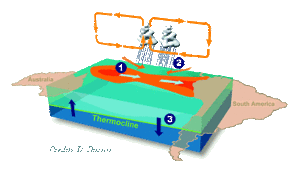For centuries, Peruvian fishermen have feared the sea warming called El Niño which, every few years, around Christmas, drastically reduces their fishing catches. These El Niño events are part of a broader disruption to normal weather patterns which causes drought, flooding and hurricanes around the world.
In the tropical Pacific, ocean and atmosphere circulations are closely linked, each reacting quickly to changes in the other.
Normal pattern
- Easterly trade winds push surface waters in the Pacific towards Australia and the Philippines, creating a warm pool at the western end of the basin (in red on the illustration) with higher temperatures and sea level.
- As the winds cross the ocean, they load up with moisture and release it as heavy rains in atmospheric convection over the warm pool.
- Meanwhile, at the eastern end of the basin, nutrient-rich cold waters well up to the surface. This is favourable for anchovy, which abounds along the Peruvian coast.
When El Niño awakens
- Westerly wind bursts at the western end of the basin allow the warm pool to drift eastward into the central Pacific. The trade winds weaken.
- Atmospheric convection, and the storm zone, move eastward with the warm pool. Heavy rainfall floods coastal areas of western South America.
- As the thermocline deepens, cold water no longer upwells off the coasts of Chile and Peru. The surface waters are warmer. Nutrients disappear; fish stocks dwindle.
La Niña pattern
- The tradewinds strengthen, shrinking the warm pool and cooling the Tropical Pacific. The climate is drier and colder off the coast of America.
- Atmospheric convection is confined to the western end of the basin. Rain is abundant over Indonesia.
- Cold waters upwells more strongly along the west coast of south America; anchovy is plentiful.








